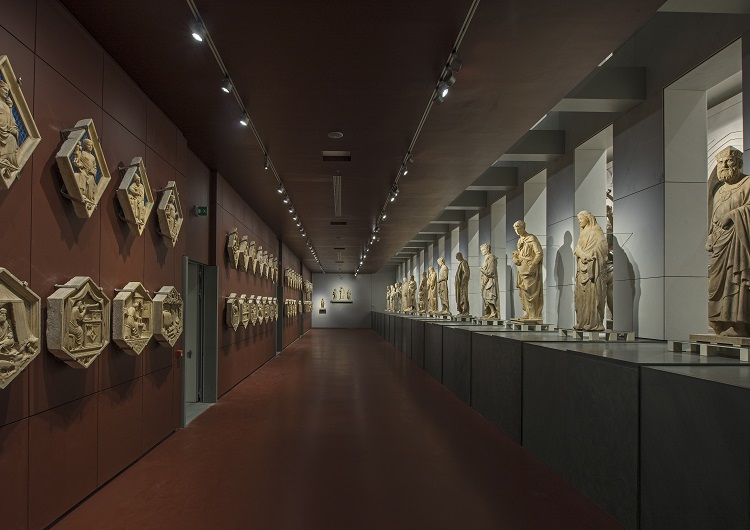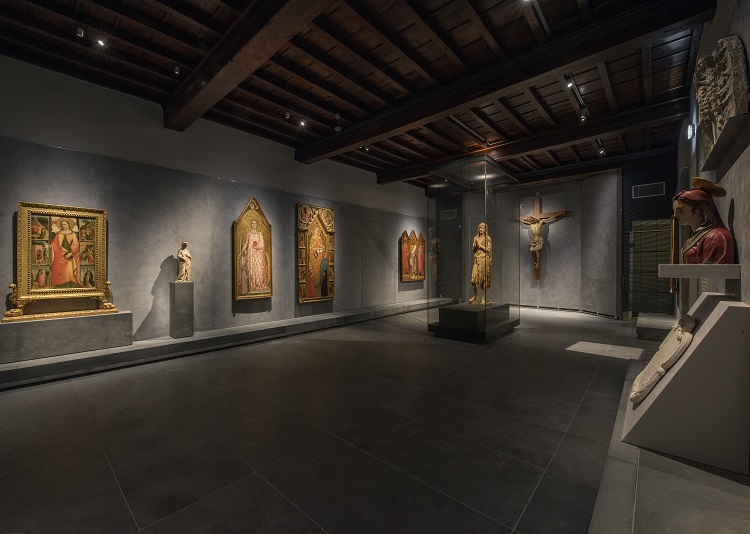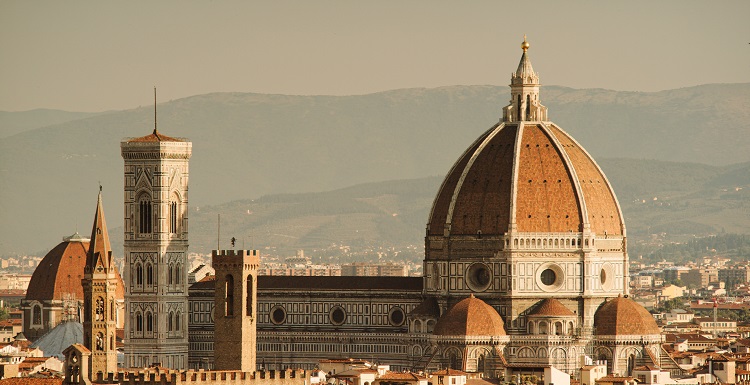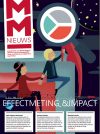
Museo dell'Opera del Duomo, Galleria del Campanile, foto Antonio Quattrone
At the centre of the Italian peninsula is Tuscany, a region which every year welcomes upwards of 25 milion visitors, drawn by its nature, cuisine and – of course – its cultural heritage. Even today, in the era of global mass tourism, many people come to cities such as Florence specifically for the masterpieces that shaped modern taste – works by Giotto, Masaccio, Botticelli, Da Vinci and Michelangelo – arriving with lists of the paintings, statues and buildings they want to see in the few days they have available.
Such intensive cultural consumerism can make it difficult, however, to communicate the deeper meaning of the works seen. For this reason the archdiocese organized an association of volunteer guides in our historic churches. Our guides stress not only the art historical but also the religious aspects of our churches. The challenge is to find a way of presenting historic buildings and images that communicate their original function and does so in universal human terms, not in sectarian or theological ones. One cannot preach to tourists, but neither can one present a crucifix as a mere aesthetic object. The crucifix must be recontextualized in its time and place, helping visitors to relate what sixteenth-century believers felt as the looked at their Saviour upon the cross.
Museum and church
Of the six Florentine churches in which volunteer guides are present to help visitors understand the meaning of the works they see, the largest and most important is the ‘Greater Duomo Museum Complex’, consisting of Florence’s famous Santa Maria del Fiore cathedral, the Romanesque baptistery and Giotto’s bell tower. As a canon of the cathedral who is also an art historian, and for fifteen years a member of the board of the Cathedral Foundation, I have been part of a process aimed at making the buildings and their contents intelligible to Florentines and visitors from abroad, through didactic itineraries, public lectures, publications, films and (today) online information.
Timothy Verdon:
The challenge is to find a way of presenting historic buildings and images that communicate their original function and does so in universal human terms, not in sectarian or theological ones. One cannot preach to tourists, but neither can one present a crucifix as a mere aesthetic object.I am also director of the new Museo dell’Opera del Duomo, the museum located behind the Cathedral, which hosts many of the most important original statues, paintings and works in gold, silver and fabric made for the Duomo and Baptistery across the centuries. The proximity to the Cathedral allows us to treat this exhibition structure as an integral part of the visitor’s experience of the sacred buildings—indeed as a hermeneutic and emotional key, the place where their full meaning becomes apparent thanks to a daring new installation and a clear didactic presentation of the meaning of our masterpieces.
Museo dell’Opera del Duomo, modello dell’Antica facciata del Duomo (1 b)
A façade reconstructed
The new role we have given the museum was made possible by the acquisition in 1998 of a building adjacent to the old Museo dell’Opera: a garage in the shell of an eighteenth-century theatre, happily stripped of its Rococo decoration in the nineteenth century. An important nucleus of our collection is the collection of almost fifty statues salvaged from the Cathedral’s original façade, which was dismantled in 1587 to make way for a more modern one. Before the old decoration was removed, however, a drawing was made by a Florentine artist, Bernardo Poccetti, documenting the appearance of this medieval front bristling with larger-than life statuary by the major sculptors of the time, and thanks to that drawing (still in the Foundation’s archives), I understood that we could, in the vast space of the garage, reconstruct the lost fourteenth-century façade, replacing the statues in their intended niches and aedicula, allowing visitors to see them again as a vision in marble of the Communion of Saints, a heavenly population at the heart of the earthly city. The medieval façade had never been decorated above one third of its overall elevation, and so the twenty-metre ceiling of the former garage was sufficient to insert the full height indicated in the drawing, and the forty-metre length of the space was almost enough for the façade’s width – we had to sacrifice a few metres at right and left, but on a 1:1 scale have the three doors with their concentration of statues and reliefs.
The vast reconstructed façade helps visitors understand how the life of a historical city was perceived in the perspective of eternity, whose representatives – Christ, Mary, the saints – in fact formed a second population, carved in stone above the piazza where the citizens of Florence gathered on important occasions. This image of the interpenetration of worlds – the earhtly and the divine – is then extended to the other side of the museum’s great hall, where on the wall facing the façade the three bronze doors of the Baptistery, itself situated in front of the Cathedral, are aligned in enormous cases beneath the sixteenth-century statuary groups made to stand above the doors. The bronze reliefs of the three doors – by Andrea Pisano, a fourteenth-century collaborator of Giotto, and Lorenzo Ghiberti, one of the proponents of the Renaissance style in the fifteenth century – altogether tell fifty Bible stories with hundreds of figures. Together with the façade, they constitute an astonishingly dense concentration of Judeo-Christian narratives
Devotion and penetance
Other spaces in the museum convey more dramatic aspects of the faith experience. Leaving the great hall, with its recreation of a sunlit square dominated by the sculptural façade, visitors enter a dimly-illuminated room with a low ceiling in which are works of devotion, paintings and statues before which people prayed. The most important of these is Donatello’s famous ‘Penitent Mary Magdalene’, carved in wood around 1453 and originally placed in the Baptistery. Our guides explain the great devotion Florentines had to this saint, believed to be the sinful woman – the prostitute – who had washed Christ’s feet with her tears and dried them with her hair, receiving pardon for her sins “because she had loved greatly”. Donatello’s image of a woman who we image once to have been beautiful, but whose current appearance speaks of harsh fasts and nights spent in prayer, must have touched people in Florence, a city with several convents of reformed prostitutes. The peace of soul in her inward gaze compensates Mary Magdalene’s bodily deterioration, proclaiming the value of Christian metanoia, conversion of life. And a large crucifix positioned behind the Magdalene – a fourteenth-century sculpture that originally stood near her in the Baptistery – reminds museum visitors that, for Christians, penance, renunciation and new life all derive from the Saviour’s sacrifice upon the cross.

Museo dell’Opera del Duomo, Sala della Maddalena di Donatello, foto Antonio Quattrone
In designing the museum installation, I took great care to position works in a way that would help visitors to make this kind of association of ideas. Approaching the case in which the Mary Magdalene stands, for example, one sees – in the room beyond her – a large ‘Pietà’ carved by Michelangelo in his old age, intended by the great artist for his own tomb. Donatello’s Magdalene too is a work of the artist’s old age, and I wanted to create a dialogue from one room to the next, in which the intense personal faith of each of these Florentine masters is the fil conducteur. Naturally I asked our architects to create a space that could evoke the strong ecclesiastical sense the work was meant to communicate, and this is what they did. The first area of the room with the ‘Pietà’ has a ceiling at the same level as that in the adjacent Magdalene room and is dimly lit; but then, as visitors approach Michelangelo’s statuary group, the ceiling rises, creating a transcendent ‘sacred space’ filled with light. My intention, grasped by our architects Adolfo Natalini, Piero Guicciardini and Marco Magni, was to evoke the kind of subliminal experience people often have entering a great church—an experience of illumination of the mind and dilation of the spirit.
Expressing faith
Ours is a Catholic museum and the art we show people is a multiform expression of traditional Christian belief. We believe moreover – as Cardinal Joseph Ratzinger, later Benedict XVI, wrote in the Catechism which he coordinated for Pope John Paul II – that images can be more powerful even than words in communicating faith. We are not trying to convert anyone – conversion is the work of the Holy Spirit – but in fairness to the artists, the patrons responsible for the works and the modern visitors, we try to let the religious message of the works speak clearly. Indeed, the works ‘want’ to communicate and we have an ethical as well as an historical obligation to facilitate this communication from one age to the next.

Cupola photo David-Battistella
The Christian humanism for which Florence was famous had one message above all: the value of the human person. Passionate interest in the human person implied interest in every phase of human development, including childred. The two cantorie or singing galleries once in our Cathedral eloquently attest to this. Carved in the 1430s by Luca della Robbia and by Donatello, they convey their message through babies and adolescents, shown dancing, singing and playing musical instruments, while bearing the words of Psalm 150, which describes a concert in the Jerusalem temple. The cantorie with their young merry-makers were made while the last structural component of Florence Cathedral, the enormous dome designed by Filippo Brunelleschi, was nearing completion. The joy which the children and young people express was thus an expression of the exultation of the people of Florence, who saw their Duomo finally finished after 140 years of economic sacrifice and hard work. But the marble children of Luca della Robbia and Donatello would have also reminded believers of their deceased children: the mortality rate in the first months and years of life was as high in medieval Europe as it is today in Third World societies. The Florentines would have been consoled, seeing their dear ones at play beneath the overarching Cathedral dome, a symbol of heaven. These are universal human realities which even the global tourist has a right to hear stated—a need to hear stated.
Religious heritage tourism in whatever faith tradition should be this: a stirring invitation to see and understand the heart of a believing people. In our narrowly secular age, many have forgotten that the most beautiful things are fruits of love, and that faith generates creativity; the visit to a historic city, its churches eloquent with statues and images, or to a sanctuary or a monastery, can communicate that privileged knowledge, confirming the basic trust in God and in human nature which theologians call ‘hope’. And that is my point: through the art of the past we can give hope for the present and future. Religious heritage tourism is much more than a cultural strategy: it is a vocation and a mission.
[Editor MMNieuws:] This article is an adaptation of the autor’s presentation at the Conference on Religious Heritage and Tourism: How to increase religious heritage tourism in a changing society, october 5-7 2016 in Utrecht, The Netherlands.
